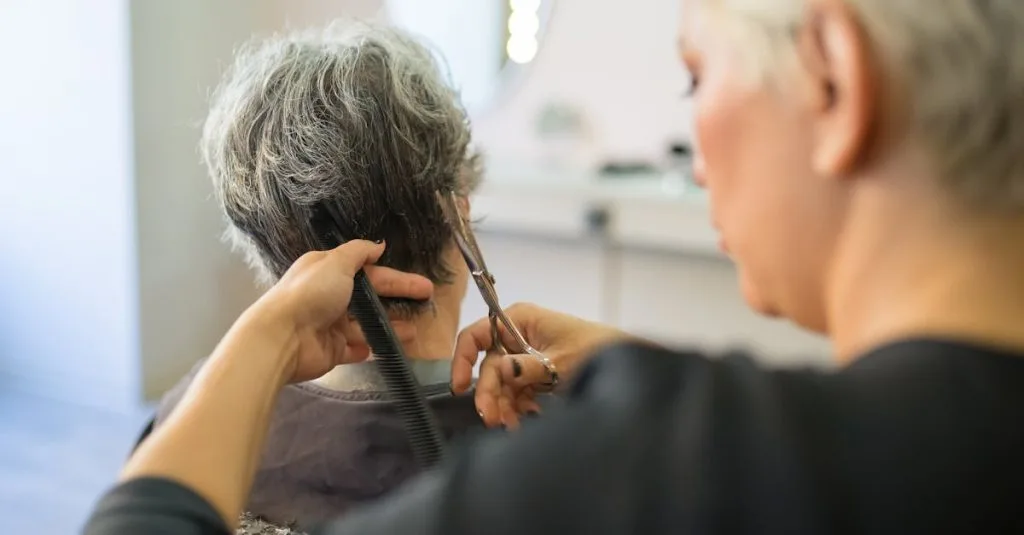A woman in midlife wonders: is hair loss in women normal, especially during midlife? She asks about it being tied to the menopause transition and also what can be done to remedy the hair loss. Jessica shares reasons why hair loss in women is normal and offers tips on how to respond.

Ask Jessica is an advice column for women in midlife. We cover all things related to midlife from changing bodies to career transitions to parenting teens to sandwich generation challenges to shifts in marital or life partnerships and everything in between. My hope is that in sharing these questions and answers I can help women as we face the midlife journey together. Got a question or challenge you would like me to address? Fill out this form to submit your issue! Want to see the answers to other questions, check out our archive here.
Is Hair Loss in Women Normal?
Hey Jessica: I’ve been trying to pretend that it isn’t happening for a while, but I can’t avoid it anymore: my hair is thinning. It has gotten to the point where I feel really self-conscious about it and don’t know how to make my hair look good. Is hair loss in women normal in midlife and is it related to menopause? Is there anything I can do about it? ~Balding Betty
Dear Balding Betty,
First off, yes, hair loss in women is normal! And especially during midlife and the menopause transition. In fact, according to Dr. Glynis Ablon, “About half of all women will have some element of hair loss by age 50, and by the age of 60, approximately 80 percent of women will experience some hair loss.” Hair loss in women in midlife can be due to the menopause transition, but there are also some other reasons it might occur. So, let’s talk about the different culprits for hair loss and then about the options you have available to remedy the situation.
There are a number of reasons why you might be experiencing hair loss:
- As our estrogen levels decrease, our androgens, which is a group of hormones that includes testosterone, stays relatively steady. What this means is that the ratio between estrogen and testosterone shifts and since testosterone is linked to hair loss, this hormone shift can lead to thinning hair.
- Genetics can also play a role in losing hair.
- Thyroid issues can trigger hair loss.
- Changes in your diet or mineral or vitamin deficiencies, including anemia, can lead to thinning hair.
- Autoimmune diseases can cause inflammation which can lead to hair loss.
- Other hormone imbalances, while more rare, can also result in thinning hair.
- High stress is another possibility. Luckily, once the stress is passed, your hair growth should return to normal (after your body recovers).
Determining why you are losing hair is going to be the first step. And the best way to do this is to go see a dermatologist. The dermatologist will likely first check to see if your hair loss looks like female pattern hair loss (i.e., a widening of your part line and a thinning of the hair overall). If it doesn’t, then they would likely move on to check for the other potential culprits listed above.
In terms of what to do about the hair loss, you have some different options. With respect to actual interventions, there are over-the-counter products that may help. Topical minoxidil can be effective, but you need to make sure that you’re consistently applying it twice a day. Another option is Nutrafol which is a supplement that women can take for hair loss. There is a version for 18-44 year-olds and one for 45 and up. A client was recently raving out how effective Nutrafol has been for her. It was recommended to her by an OB/GYN I really like and respect whose entire practice is focused on women in midlife.
There are also prescriptions that can help, depending on your situation. They include Spironolactone, oral minoxidil, hormone medications, and platelet rich plasma injections. All of these would obviously require a conversation with your doctor. And, if you are really worried about it or have really significant hair loss, hair transplantation is another option.
Finally, there are non-drug related interventions to consider including a new hair cut or hairstyle that helps to make your hair look fuller, hair powders which coat your existing hair and make it look thicker, and wigs and hair pieces, which have come a very, very long way in terms of looking real (or you could embrace your inner Moira Rose and collect and name a variety of wigs).
I know that this change can be really unnerving, so please take some solace in knowing that you are not alone and that there are many options to explore, with likely the best first move being to schedule an appointment with a dermatologist and maybe one with your hairdresser, too. Good luck!
